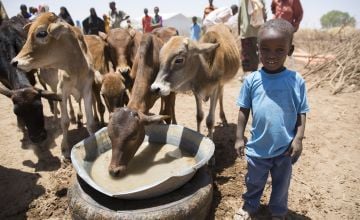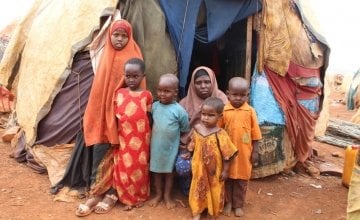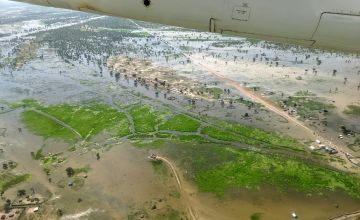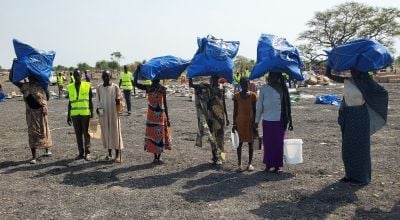
Read our 2023 annual report

Knowledge Hub
Since the 1970s, researchers have been exploring how climate change and conflict intersect.
While it’s generally agreed that climate change, in itself, does not lead to violent conflict, there are still a number of ways that the two work together to form a deadly partnership.
A recent study from UNOCHA shows that the countries with a high level of violence are more vulnerable to climate change. The Notre Dame Global Adaptation Initiative Index confirms this: Among the countries ranked as most vulnerable to climate change, Afghanistan, the Democratic Republic of Congo, Mali, Somalia and Yemen are all in states of violent, protracted conflict. Climate change is a threat-multiplier for conflict, and vice-versa. Here are some ways each one influences the other.
Five ways climate change influences conflict
1. The climate crisis means people lose out on income
Several studies have proven the link between conflict and climate change, especially within farming and herding communities. The breakdown happens because farmers and pastoralists directly depend on a consistent ecosystem for their livelihoods. Drought, floods, land degradation, and exploitation of resources limit their harvests, kill their livestock, and result in lost incomes. If this pattern becomes chronic, it can lead to a breakdown in the social contract as people struggle to cope.
Violent conflict thrives in these conditions. For example, in Somalia, the UN reports that economic hardships resulting from the climate crisis “lowers the threshold” for people to engage in violent activities.
Another example of this comes out of present-day South Sudan. In 1991, a flood devastated crops and livestock throughout the Upper Nile area of the country. Members of the pastoralist Dinka and Nuer tribes who had lost many of their resources reacted in a common way for the area: cattle raiding. While they saw this as an opportunity to make up for their losses due to the flood, in the end the Dinka-Nuer conflict caused only more damage, including the loss of lives and destruction of communities.

2. Climate change leads to increased migration
It’s a fairly simple conclusion: If you rely on the land for your livelihood and your land is failing you, one of the only solutions is to seek out different land. But the problem with this is scale. Climate extremes mean that millions of people around the world have been failed by their land and made the difficult decision to leave home in search of better fortunes. Resources have become that much harder to find. Tensions escalate as migrants compete with locals for land and water.
These tensions can become amplified if race or ethnicity are part of the equation. During the 1980s and 1990s, a mass migration in Sudan was driven by people in search of areas with greater land resources. This led to an increase in violence.

3. Natural resources and local conflicts can be exploited by the elites
The conflicts surrounding natural resources can be devastating and deadly. But they are also relatively small given that they often cover a specific area within a country. However, these conflicts can be used as rallying methods by local and national elites to cover up their own shortcomings and mobilise support by furthering an “us vs. them” mentality. What begins as a hyper-local fight for resources in one part of the country can soon become a national issue — with an increase in violence to match.
4. Worsening climate conditions can lead to increased political instability
The Syrian conflict has several root causes, but among them is climate. Unpredictable weather patterns had led to a multi-year drought in the country, beginning in the mid-2000s. This was complemented by ineffective watershed management and unmodernised irrigation systems, leading to mass water shortages. Water became a luxury, leading to large-scale displacement, food insecurity, and unemployment for more than a million Syrians. This eventually contributed to political instability.

5. Climate change hinders peacekeeping missions
Extreme weather events and climate disasters can also prevent peace, prolonging existing conflict. The United Nations Assistance Mission in Somalia has cited climate-related environmental change as a hindrance to its peacekeeping mission in the country. This is because it exacerbates three of the challenges responsible for the crisis in Somalia: farmer-herder conflicts, insurgent group recruitment, and competition over land. While this may seem like a chicken-egg scenario, the end result is the same: prolonged violence that affects more people the longer it goes on.
Four ways conflict contributes to the climate crisis
1. Conflict often involves a literal “scorched earth” policy
The International Red Cross has called the environment the “neglected victim of armed conflict". This isn’t a statement made lightly: The Geneva Convention, which governs ethical warfare, has protections against the environment as well as people. These are often ignored. Over the last 45 years, conflict in Lebanon saw forest cover being burned for strategic purposes, and coordinated fires at times where the locations could not be easily reached due to the conflict, thereby allowing them to burn longer and at greater intensity.
When natural vegetation is burned down, it releases the carbon taken in by plants and vegetation into the atmosphere, and eliminates future protection. This can lead to soil erosion, making it more difficult to rebuild after the conflict has subsided. Since 1975, Lebanon has lost over 2,500 acres of vegetation cover. A study conducted by scientists from the Universities of Balamand (Lebanon), Twente (Netherlands), and Leeds (United Kingdom) showed that these changes in land coverage are the effects of repetitive armed conflicts in many of the affected areas, particularly around Tripoli.

2. Water is another casualty of war
Water points are also a common target of attacks, leading to a ripple effect of consequences. Conflict that affects coastal areas can lead to coastline degradation which leads to reduced water circulation, altered currents, and a stripped sea bed — all of which can have, according to the same Lebanon study, “significant effect” on marine life.
Even in landlocked countries, water is both a weapon and casualty of war.
3. Conflict creates population density, exploiting further resources
Forced migration is one of the consequences of conflict. One of the characteristics of an unsustainable society is poorly-managed migration. Growing evidence suggests that migration — and the pressure on land that it causes — is a serious problem in many countries.
This is especially true in situations where resources are already tight. The influx of refugees or IDPs can add further strain to areas where demand has already exceeded supply. This can lead to further land degradation, erosion, and water shortages.

4. Conflict weakens people’s ability to respond to climate shocks
In South Sudan, the unpredictability of the climate has made it difficult for both policy-makers and families to plan for the future, which leaves both governments and individuals ill-prepared to deal with climate shocks. We saw this just recently in South Sudan, whose Unity State was hit with the worst floods in the region since 1962 last December.
Prior to the flooding, Unity State had extensive humanitarian needs, including two-thirds of the population facing high levels of hunger, brought about largely by conflict and political instability. “Tension among communities has also increased due to pressure on limited resources and further aggravation of the need for humanitarian assistance,” says Concern’s Country Director in South Sudan, Shumon Sengupta.
While Concern worked tirelessly alongside other agencies in the area, the needs have far exceeded the current scale of response. This is true both within and outside of the camps for internally-displaced South Sudanese, many of whom have spent years in informal tents designed to be used for a few days at most. With access to basic services limited and local infrastructure weakened, it creates the perfect storm of factors to escalate an already critical crisis.




